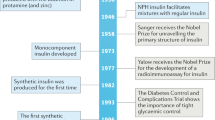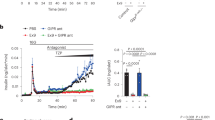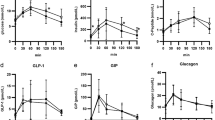Abstract
SULPHONYLUREA drugs have been widely used in the management of the form of diabetes mellitus which develops in adulthood. Although some endogenous insulin secretory capacity seems to be necessary for Sulphonylureas to be effective (they are ineffective in pancreatectomised animals), their precise mechanism of action has not been clear. Short-term administration of Sulphonylureas to animals or humans is associated with increased insulin secretion1,2. However, prolonged administration reduces pancreatic insulin content in animals3,4 and diminished insulin secretion in reponse to nutrient stimulation in both laboratory animals5 and humans with adult-onset (insulin-independent) diabetes6,7. Treatment with sulphonylureas also decreases the biosynthesis of proinsulin8. Thus, the chronic antidiabetic action of Sulphonylureas does not seem to result from an effect on insulin release, but rather from one or more extrapancreatic effects9,10. In that connection, we have shown that chronic administration of the sulphonylurea, glipizide, to patients with adult-onset diabetes mellitus results in significant potentiation of insulin action, as assessed by changes in insulin-mediated glucose disposal11. On the basis of those results, we have suggested that glipizide influences the interaction of insulin with the cell membranes in insulin-sensitive tissues. We now report that, in an animal model, such an effect involves an increase in the number of insulin receptors.
This is a preview of subscription content, access via your institution
Access options
Subscribe to this journal
Receive 51 print issues and online access
$199.00 per year
only $3.90 per issue
Buy this article
- Purchase on Springer Link
- Instant access to full article PDF
Prices may be subject to local taxes which are calculated during checkout
Similar content being viewed by others
References
Pfeiffer, E. F., Pfeiffer, M., Ditschuneit, H. & Ahn, C. Ann. N.Y. Acad. Sci. 82, 479–495 (1959).
Yalow, R. S., Black, H., Villazon, M. & Berson, S. A. Diabetes 9, 356–362 (1960).
Sodoyez, J. C., Sodoyez-Goffauz, F. & Foa, P. P. Diabetes 19, 603–609 (1970).
Schauder, P., Arends, J. & Frerichs, H. Metabolism 26, 9–15 (1977).
Dunbar, J. C. & Foa, P. P. Diabetologica 10, 27–35 (1974).
Reaven, G. & Gray, J. Diabetes 16, 487–492 (1967).
Duckworth, W. C., Solomon, S. S. & Kitabchi, A. E. J. clin. Endocr. Metab. 35, 585–591 (1972).
Levy, J. & Malaisse, W. J. Biochem. Pharmac. 24, 235–239 (1975).
Feldman, J. M. & Lebovitz, H. E. Archs intern. Med. 123, 314–322 (1969).
Levey, G. S. Fedn Proc. 36, 2720–2723 (1977).
Lebovitz, H. E., Feinglos, M. N., Bucholtz, H. K. & Lebovitz, F. L. J. clin. Endocr. Metab. 45, 601–604 (1977).
Solyom, A. & Trams, E. G. Enzyme 13, 329–372 (1972).
Mackler, B. Meth. Enzym. 10, 261–263 (1967).
Lowry, O. H., Rosebrough, N. J., Farr, A. L. & Randall, R. J. J. biol. Chem. 193, 265–275 (1951).
Kahn, C. R., Freychet, P., Roth, J. & Neville, D. M., Jr J. biol. Chem. 249, 2249–2257 (1974).
Scatchard, G. Ann. N.Y. Acad. Sci. 51, 660–672 (1949).
Reaven, G. M., Bernstein, R., Davis, B. & Olefsky, J. M. Am. J. Med. 60, 80–88 (1976).
Olefsky, J. M. & Reaven, G. M. Am. J. Med. 60, 89–95 (1976).
Archer, J. A., Gorden, P. & Roth, J. J. clin. Invest. 55, 166–174 (1975).
Kahn, C. R. & Roth, J. in Hormone-Receptor Interaction: Molecular Aspects (ed. Levey, G. S.) (Marcel Dekker, New York, 1976).
Thomopoulos, P., Kosmakos, F. C., Pastan, I. & Lovelace, E. Biochem. biophys. Res. Commun. 75, 246–253 (1977).
Author information
Authors and Affiliations
Rights and permissions
About this article
Cite this article
FEINGLOS, M., LEBOVITZ, H. Sulphonylureas increase the number of insulin receptors. Nature 276, 184–185 (1978). https://doi.org/10.1038/276184a0
Received:
Accepted:
Issue Date:
DOI: https://doi.org/10.1038/276184a0
This article is cited by
-
A novel mechanism of glipizide sulfonylurea action: decreased metabolic clearance rate of insulin
Acta Diabetologica (1995)
-
Studies on the mechanism of action of sulphonylureas in type II diabetic subjects: gliquidone
Journal of Endocrinological Investigation (1992)
-
Extrapancreatic insulin effect of glibenclamide
European Journal of Clinical Pharmacology (1991)
-
The effect of sulphonylurea on the in vivo tissue uptake of glucose in normal rats
Diabetologia (1987)
-
Changes in insulin receptor functions of the erythrocyte by treatment of non-insulin-dependent diabetes mellitus (NIDDM) patients with glibenclamide and diet control
Acta Diabetologica Latina (1986)
Comments
By submitting a comment you agree to abide by our Terms and Community Guidelines. If you find something abusive or that does not comply with our terms or guidelines please flag it as inappropriate.



